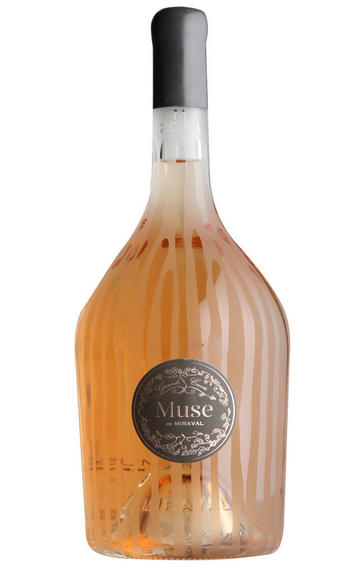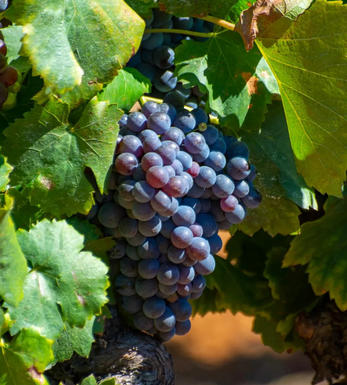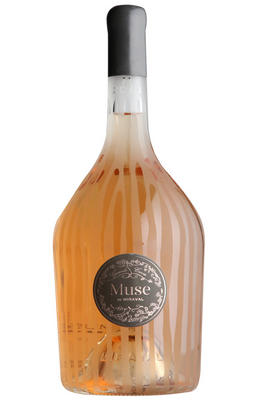
About this WINE

Miraval
Miraval is located close to the ancient town of Correns, just to the north of Brignoles right in the heart of Provence. The property is, if you will forgive the hyperbole, pretty much as close to paradise as it is possible to be, a terraced oasis nestling in the forests and scrub of the Mediterranean.
Its history goes some way to explain the magical aura which pervades the valley; located close to the Roman road Via Aurelia, Miraval was the site of a monastery in the Middle Ages, thereafter a refuge for the Bourbon kings. More recently, it has been a peaceful retreat for latter-day troubadours, its recording studio tempting the likes of Sting, Sade and Pink Floyd to record some of their finest work over the years.
Inspiration is clearly not hard to come by here. The latest incumbents are no strangers to fame and fortune; not only is Miraval the summer retreat of Angelina Jolie and Brad Pitt, but it is also the winery where they have launched a joint venture with the Perrin family of the renowned Château de Beaucastel in the Rhône Valley.

Provence
The Roman poet Martial once condemned the wines of Provence’s capital Marseilles as “terrible poisons, and never sold at a good price”. Fortunately, this harrowing proclamation was born of envy.
Quite how long winemaking has been going on in Provence is a matter of historical debate, but it is thought that it dates back as far as the Greek founding of Massilia (now Marseilles) in 600 BC.
Although Rome tried to curtail the production of wine here so as to favour exports of Italian goods throughout the Empire, soldiers retiring from the legions undermined them by privately continuing to grow grapes in this area of France they called Provincia Nostra (‘our province’).
Like other areas in the Mediterranean, Provence has played host to a series of cultures during its history, and each one has added its own touch to the region’s winemaking, particularly in terms of grape varieties. Simply listing some of the grapes found in the province gives a good idea of this variance, as they include Carignan, Cinsault, Grenache (the most planted), Ugni Blanc, Clairette, the indigenous Calitor, Barbaroux, Rolle (Vermentino) and Sémillon, amongst others.
Provence, to the east of Languedoc-Rousillon,is blessed with a Mediterranean climate, entailing warm summers and mild winters. With an annual average of up to 3,000 hours, excessive sun is a concern for many vines. Fortunately the heat is alleviated by the northerly mistral wind, and the risk of fungal diseases is minimal – which makes Provence suitable for organic viticulture.
The region is predominantly known for its rosé wines, which account for over half of Provençal production and are usually dry. The tiny enclave of Cassis stands out as a predominantly white wine region.
Provence’s Appellations d'Origine Contrôlée (AOC) are:
- Coteaux d’Aix-en-Provence
- Les Baux-de-Provence
- Coteaux Varois
- Côtes de Provence (the largest appellation)
- Bandol
- Cassis
- Bellet
- Palette
Vin de pays is also produced throughout the region.

Cinsault
Cinsault (pronounced "sin-so") is a red grape variety known for its versatility and contributions to various wine regions worldwide. It has a rich history, primarily in the Languedoc region of southern France, but it has spread to many other wine-producing areas due to its adaptability to different climates.
Cinsault grapes are medium-sized with thin skins, typically dark blue to black in colour. The vines are hardy and drought-resistant grapevine, making them suitable for warm and arid climates. They are particularly well-suited to Mediterranean regions and thrive in areas with hot summers.
While Cinsault is mainly used in red wine production, it is also sometimes used in rosé wines, adding light and fruity character. It is often blended with other grape varieties to enhance the wine profile.
The variety tends to exhibit a range of flavours, including red berries, cherries, and sometimes a hint of spices. When used in rosé wines, it can bring out more floral and watermelon notes.
Tannins are typically on the lower side, which can make them more approachable and enjoyable in their youth. The variety is often used in blends to soften and round out more tannic grape varieties.
Cinsault has been a key component in traditional blends in southern France, such as in Châteauneuf-du-Pape wines. Over time, it has gained popularity in other wine regions as winemakers recognize its potential for producing high-quality wines.



Buying options
Add to wishlist
wine at a glance
Delivery and quality guarantee